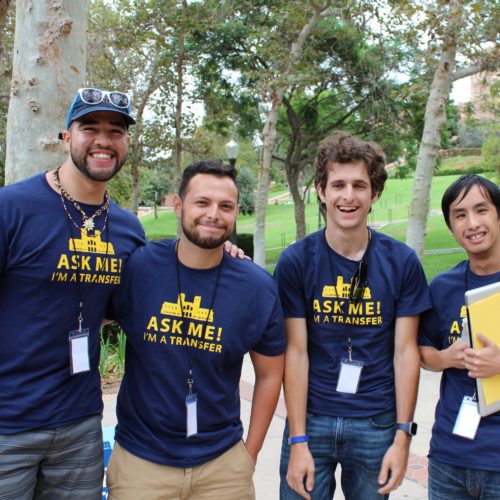How to Be a Cornerman for Community College Transfer Students
Lessons from Amherst College
Yazmin Padilla
December 8, 2021
Reading Time: 6 minutes
What does Rocky Balboa have in common with a transfer student? Think back to those movies where Rocky exhorts his son, “It ain’t about how hard you hit, it's about how hard you can get hit and keep moving forward.” Now think about the transfer student journey, about all the challenges from enrollment to graduation: Lack of transferred credits from a community college to a four-year institution, inadequate financial aid, absence of specialized resources.
It takes a persistent person to make it through an educational system that was not designed for transfers.
While 80 percent of new community college students aim to earn a bachelor's degree, only 14 percent do so within six years of starting college. This is even though 41 percent of first-time degree-seeking students at community colleges are high achievers with a grade point average between 3.0 and 4.0. Community college students offer workforce diversity—they are older on average than other undergraduates; they have military or work experience, and they tend to be people of color. It’s time for higher education institutions to ask themselves, how can we be a cornerman for community college transfer students?
Amherst College in Massachusetts, founded 200 years ago, is one of the country’s most selective private institutions, accepting just one in every 10 applicants. Yet Amherst has established itself as a cornerman in the community college transfer student journey, consistently enrolling 10-15 new community college transfer students a year (out of around 495 new students).
Amherst began this journey at the height of an economic recession. In 2010, Amherst was reaching the end of a Jack Kent Cooke Foundation (JKCF) grant designed to lay the foundation for a community college transfer program. Instead of abandoning the project altogether, they decided to double down on their commitment to enrolling community college transfer students.
The American Talent Institute (ATI) had the opportunity to learn about how this work progressed 11 years later from Alexandra Hurd, Amherst College’s associate dean of admission. An Amherst alumna, Hurd has over a decade of experience in higher education specialized in community college transfer.
We asked about four areas: recruiting and enrolling community college students; offering sufficient financial aid; creating specialized transfer resources; and involving campus faculty. She helped us understand how this commitment to transfer students looks in practice.
Can you start by telling us something surprising to show why Amherst has become a transfer-friendly college?
This starts at the top: President Biddy Martin is deeply involved in transfer programming. “President Martin has really pushed us past the point of representation and to a conversation on inclusion,” Hurd said, adding that the president hosts transfer students at her house for lunches and tea. “She wants to hear what their experiences are and how they are navigating the campus.”
The board of trustees, faculty, and staff also embody President Martin’s commitment to transfer. “They’re all committed to learning more about the transfer population, specifically our community college and student veteran initiatives. Having commitment from leadership helps initiatives and amplifies student voices,” Hurd said.
Sometimes we hear that faculty support is a challenge as colleges work to integrate transfer students. What role do faculty play at Amherst?
Amherst has a staff liaison to support and advocate for transfer students, Hurd said, adding that community college students bring a strong work ethic and a different perspective to classroom discussions. “They’re an institutional priority,” Hurd said. “As the JKCF grant was ending in 2010, there were a lot of questions about funding and whether Amherst should continue our community college transfer initiative—especially due to the recession. Faculty very much supported the program and voiced how much they value having these students in their classrooms and as part of the community. These voices were incredibly influential in the decision to permanently institute Amherst's community college transfer program."
What advice would you give to colleges struggling with faculty support for transfers?
“Encourage the president to find faculty and staff who have an interest in the initiative. Explore ways for these faculty and staff to collaborate with local community colleges and speak with their colleagues at peer institutions with established community college transfer programs. That way, they can learn what has worked for others and what challenges to anticipate," Hurd replied. She also noted that initiative and interest from leadership is a strong motivator in leading efforts to create a transfer-friendly campus.
What are the strategies that have led to Amherst’s success in enrolling community college students?
Amherst has found that recruiting and enrolling community college students requires a different approach than traditional candidates, Hurd said. The community college transfer student experience does not start at a four-year institution; transfer students are already far along in their higher education journeys. To honor the transfer student experience means to acknowledge the work that student has put in before reaching your institution. Amherst does this in three core ways: training counselors to think from the transfer student experience, sharing admission and financial aid information clearly, and being transparent and flexible about credit transfer.
The admissions section of Amherst’s website has a dedicated page for prospective community college transfer students. Aspiring transfer students can easily find this page within the “Transfer to Amherst” menu. They can find information on eligibility, transfer of credit, financial aid, and resources tailored for transfer students. With this tab, students don’t get lost clicking around a page, trying to guess how their own journey could fit into the mold of an applicant applying right from high school.
How does Amherst approach articulation agreements and the transfer of credits?
Students are eligible to apply for transfer to Amherst after completing 32 transferable semester hour credits at a community college. At the point of admissions, students receive an evaluation of their credits that clearly states which courses will transfer, as well as their graduation date, class year, and financial aid package. Because Amherst has no general education requirements or core curriculum, most liberal arts credits will apply toward students’ bachelor’s degrees. This is a significant advantage for transfers to Amherst; transfer students across the U.S. too often find that credits accumulated at community college don’t apply to their bachelor’s degrees, leading to more time and money spent at a four-year institution.
Most community college transfers enter Amherst as sophomores, and all community college transfers enter knowing exactly how many semesters they have left to graduate. Due to the open curriculum and strong advising system, Hurd said, students do not spend additional semesters completing their degree beyond the anticipated graduation date.
What does support for community college transfer students look like at Amherst?
First, Amherst guarantees need-blind admission and meets one hundred percent of all students' demonstrated financial need without including student loans in their financial aid packages. This is especially important for transfer students, who tend to have higher financial need. In 2020, transfer students received an average award of over $69,000, covering a large portion of the $80,000 estimated total cost of attendance. (In comparison, the average aid package for the overall student body in 2020 was $59,000.) For students with additional need, Amherst provides annual grants of $1,000 to cover expenses that often go unaccounted for, such as laptops, appropriate clothing for job interviews, and fees associated with applying to graduate school.
Second, Amherst provides a sense of community from day one. Students join a cohort of community college transfer students who meet through various transfer-specific events and programs: orientation groups, the on-campus housing community, and social events like barbecues and visits to the campus farm. They also have access to the Class & Access Resource Center, whose mission includes working with first-generation, low-income, transfer, and veteran students. In addition to planning transfer orientation, the CARC center hosts a welcome dinner, alumni panels, and creates resources on post-graduation opportunities, all of which are specifically designed for transfer students.
Transfer students can also run for transfer student senator, who represents the transfer community within Amherst’s student government. After graduation, they join a network of exceptional alumni, some of whom have become Fulbright scholars, authors, educators, and engineers.
Many institutions feel overwhelmed by the prospect of starting from square one when designing a campus that is friendly to transfer students. Was there a need to completely invest in new supports for transfer students?
Many of the needs of transfer students are similar to the needs of other students that Amherst hopes to enroll to create an intentionally diverse and inclusive campus community. These supports include counseling services, the academic advising hub, the writing center, wellness programs, peer advising, the career advising center, and intensive faculty advising. Designing a campus that is transfer-friendly does not require reinventing the wheel, but rather evaluating which campus resources could also support transfer students and expanding or slightly revising those programs to align with the needs and interests of transfer students. As an example, Amherst expanded eligibility of the Meiklejohn Fellows Program, which provides networking, career advising, and a guaranteed paid internship, to include transfer students.
At the same time, Hurd stressed the importance of providing dedicated space for community college transfer students to share their unique experiences. By hearing from students directly, administrators and faculty can think creatively about how to address transfer students’ needs and concerns.
Transfer Resources for ATI Members
Want to better honor your transfer students’ experiences? Find additional transfer resources at https://highered.aspeninstitute.org/.
ATI member institutions have the opportunity to join the Transfer Community of Practice, a community and space dedicated to sharing best practices related to transfer. Please reach out to Ben Fresquez at Ben.Fresquez@aspeninstitute.org to learn more about joining.





